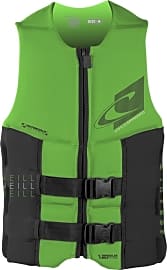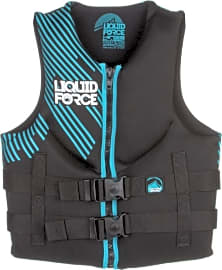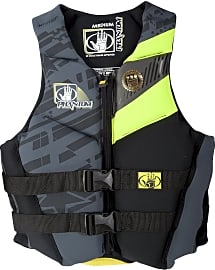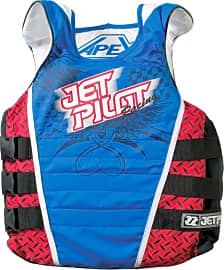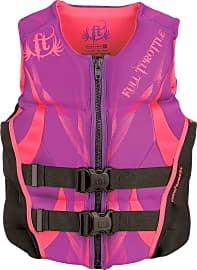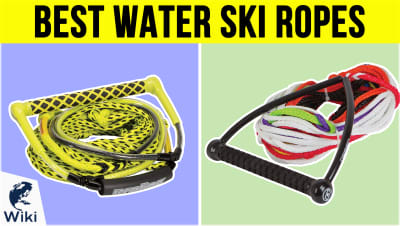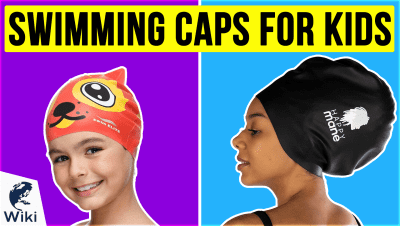The 10 Best Wakeboard Vests

This wiki has been updated 38 times since it was first published in July of 2015. Unlike their traditional lifesaving counterparts, wakeboard vests are specifically designed to be more lightweight, fit more snugly, and allow for more flexibility and range of motion — all features that should result in a safer and more comfortable experience on the water. The models in this selection check those boxes and more, and are suitable for a wide variety of body types. When users buy our independently chosen editorial picks, we may earn commissions to help fund the Wiki.
Editor's Notes
March 03, 2020:
Wakeboarding vests come in Coast Guard-approved (USCG) and competition models, so we wanted to make sure to showcase both styles on this list. It is important though, that anyone considering a competition model understands the difference and is willing to accept the risks that come along with them, namely their limited flotation capabilities and legal compliance with state regulations.
The above being stated, competition vests do offer some benefits, as well. For example, models like the O'Neill Slasher and Ronix One Custom Fit, which are the only two competition vests on our list, will offer greater flexibility and range of motion. They also generally have a thinner profile and conform better to the body, all of which will make it easier to grab and maneuver the ski rope. This can be due to their core construction, which in the case of the Slasher is Nytrolite foam, or other features, like the Boa fit system on the Ronix One. Both of these models also offer decent impact protection.
For the average user, a USCG vest will probably be the smartest and safest option. Thankfully, models like the O'Neill Assault have done a very good job of balancing bulkiness with lifesaving capabilities. It features a multitude of flex points, so as not to hinder your motion, and boasts the same Nytrolite core as the Slasher. One of the main differences between it and its competition counterparts, and what allows it to be Coast Guard approved, is the addition of two buckles to its closure system.
If you like to go fast on the water, the JetPilot Apex is a good choice. It is made by a company well known for making jet skiing vests, and they have incorporated much of the same technology into the Apex as they do their PWC models, which results in it having a 100-MPH speed rating.
Since riding up is a known issue in life vests of all kinds, despite manufacturers' best efforts to combat it, some of our readers may want to opt for the O'Neill Superlite, Body Glove Phantom, or Body Glove Method Nylon, all of which have a deep-V neckline to minimize the chances of it causing discomfort.
Special Honors
Billabong Palms Wake Vest With a tropical motif and split foam panels, the Palms Competition Wake Vest will have you looking good on the water as you twist and turn your body in whichever direction you need. It has flatlock seams to minimize the chances of chafing and is designed with a focus on impact protection. billabong.com
A Brief History Of Wakeboarding
It was started in either New Zealand or Australia and performed on bindingless hand-shaped boards that were created specifically for towing.
Wakeboarding is a much more recent sport than surfing or skiing. It first arose sometime in the late 1970s, but wouldn't actually become popular until many years later. It was started in either New Zealand or Australia and performed on bindingless hand-shaped boards that were created specifically for towing. Originally the sport was known as skurfing because it combined some aspects of both skiing and surfing, and the wakeboard was called a skurfboard.
Sometime in the early 1980s, Australian Jeff Darby was lent a skurfboard from one of his friends. He found the sport so enjoyable that he decided to try and create his own skurfboards. He would eventually partner with Tony Finn, a San Diego surfer, to establish the brand Skurfer. Around the same time, a surfer in Jacksonville, Florida by the name of Howard Jacobs was experimenting with his own style of wakeboard. He started by attaching windsurfing foot straps and bits of hydroslide padding to smaller surfboards. It wasn't long before he was being towed behind boats and popping backflips on the St. Johns River.
The first mass-produced plastic, roto-molded wakeboard was brought to the market by Bruce McKee, an Australian surfboard shaper, and Mitchell Ross. They called their board the McSki, initially launching it in the Australian market. It featured adjustable rubber straps for the feet, and had a keel fin and concave bottom. Later, they added two additional side fins for better maneuverability, and renamed it the SSS, and finally the Wake-Snake.
By 1985, both the Skurfer and the Wake-Snake had entered the American market, though by this time the Wake-Snake was renamed again to the Surf-Ski. Also in 1985, another player by the name of Jimmy Redmon entered the market with his own independently-developed wakeboards, which he sold under the brand name Redline Designs. Finn and Redmon would eventually partner up to found Liquid Force, a company that still sells wakeboards to this day.
Throughout the 1980s, wakeboards were called a number of different things, including kurboards, skiboards, and the aforementioned skurfboard. By the end of the decade, the name skiboard stuck, and in 1989, The World Skiboard Association was founded, with the first world championship held on the Wailua River in Kauai, Hawaii the same year. Paul Fraser is responsible for coining the term wakeboard in the early 1990s when he released the Hyperlite. His revolutionary board was compression-molded, as opposed to the roto-molding of earlier models, and was more neutrally buoyant, allowing for easier starts.
Choosing The Right Size Wakeboard Vest
Life jackets are named as such because they are designed to save your life, making them the most important piece of equipment you'll use on the water. Not only will they help you float back up to the surface if you are ever knocked unconscious, but many can also protect your rib bones and vital organs from damage in a crash. For this reason, while it may be okay to skimp on your tow rope or board, you should never skimp on a wakeboard vest.
If it doesn't fit for any reason, it's better to know now rather than later, when you are getting geared up on the boat.
Just as it's important to buy a good quality vest, it's equally important to buy one that fits you correctly. Sure, wearing an improperly fitting vest is somewhat better than wearing nothing at all, but it just can't compare to one that fits your body snugly enough to never slip off when you hit the water. As with any apparel, something that fits your friend well may not be ideal for you, so it's best to get your own, even if you don't have your own board and use a friend's every weekend.
When looking at the different wakeboard vests online, pay attention to the manufacturer's recommended weight range and chest size. Some people fall into a category where their chest size indicates they should purchase one size vest, while their weight indicates another. If you find yourself in this predicament, choose the one that corresponds to your chest size, as this is a more accurate indicator of a proper fit. When your wakeboard vest arrives, you should try it on at your home long before you ever go out and hit the waves. If it doesn't fit for any reason, it's better to know now rather than later, when you are getting geared up on the boat. Vests tend to stretch when they get wet, so when you try it on on dry land, it should be snug enough that it feels like a second skin.
Wakeboard Vest Classifications
Wakeboard vests fall into two classifications: United States Coast Guard Approved and competition. USCGA vests undergo stringent tests set forth by the Coast Guard to ensure they properly float in a variety of situations. This makes them a smart choice for the recreational wakeboarder who won't have safety and medical personnel watching their every move while they ride. Pretty much all USCGA vests have a quick-release buckle closure system with nylon straps. They may not look as cool as competition vests, but when it comes to saving your life, coolness is the last factor that should be considered.
Competition vests are completely unregulated. This obviously doesn't mean that the manufacturer doesn't take safety into account and sells vests that will allow you to sink as soon as you hit the water, but it does mean that some float significantly better than other models. Without an official approval by a governing party, you won't know how well a vest will float until you are in the water. If you do decide to go with a competition vest, it is a smart idea to take it out to the water and test it a little bit before ever taking your first ride in it. This way, if it doesn't float well enough, you have the time to return it and purchase another model before you find yourself in a situation where you might need it to save your life. Competition vests may have a zipper closure, buckle closure, or some combination of the two.




